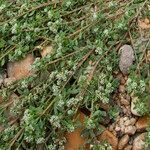Glabrous annual, 0.01-0.10 m high, stems decumbent. Leaves alternate, subsessile, spathulate or linear, glaucous. Inflorescences dense, terminal and lateral cymes. Flowers bisexual, small, slightly perigynous. Sepals 5, persistent, green, margins white. Petals 5, membranous, white, shorter than sepals, oval. Stamens 5, filaments short. Ovary 1-locular; ovule solitary; style short; stigmas 3, subsessile; cleistogamous. Fruit a trigonous nutlet. Seeds globose-ovoid.
Leaves alternate, up to 1·7 (2·5) × 0·3 (0–5) cm., narrowly oblanceolate or narrowly elliptic, apex acute or more rarely obtuse, narrowing gradually to the sessile or subsessile base, glaucous, midrib prominent, lateral nerves inconspicuous; stipules whitish, c. 1·5 × 1 mm., membranous, asymmetrically ovate-auriculate, margins subentire or irregularly crenate.
An annual bushy plant. It had a tap-root. The stems are 30 cm long. They lie along the ground. The leaves are alternate and narrowly sword shaped. The flowers are in clusters at the ends of the branches or in the axils of leaves. They are greenish-white. The fruit is oval and have a covering.
Flowers in compact, axillary or terminal, sessile or very shortly pedunculate clusters on leafy branches; pedicels very short and scarcely visible or sometimes up to 1 mm. long; bracts up to 1 mm. long, membranous, whitish, ovate. Receptacle 0·75–1·35 mm. long, broadly turbinate.
Prostrate annual, biennial or perennial, with reclining, slender stems up to 400 mm long, much branched from base. Leaves narrowly oblanceolate, glabrous or softly hairy. Flowers in terminal and axillary clusters, 1.25-1.75 mm long, greenish white.
Prostrate annual or perennial to 3 cm. Leaves oblanceolate, stipules ± 2.5 mm long, usually white. Flowers in terminal and axillary clusters, 1.25-1.75 mm long, greenish.
Annual or perhaps sometimes a perennial, glabrous, much-branched, bushy or spreading herb with a long tap-root; stems prostrate or ascending, up to c. 30 cm. long.
Fruit c. 0·9 × 0·7 mm., trigonously ovoid, enclosed in the persistent perianth, horn-coloured, minutely granular.
Sepals 0·5–0·8 × 0·3–0·8 mm., ovate-oblong, obtuse, margins membranous.
Petals white, 0·3–0·55 × 0·3–0·4 mm., membranous, oblong.
Ovary ovoid, with 3 subsessile spreading stigmas.
Stamens shorter than the petals; anthers ovate.
Seed c. 0·7 mm. in diam., subglobose.


